Telescopes We Work With
(Click on images for larger versions)

Telescopes We Work With(Click on images for larger versions) |

|
So one of the pleasures of being an astronomer is travelling to various telescopes on observing trips. The locations are great, the people running the observatories are simply fantastic, and the trips are always fun.
That's how it used to be, anyway. Nowadays, civilization is harder to get away from: a tiny cellphone placed on the moon would be the third-brightest source in the entire radio sky! Observatories are also more automated, and some are in space. So data is just as likely to arrive as a tape in the mail - more efficient, no doubt, but not quite the same thing as being there when you're observing.
Here are some telescopes our group has worked with, and my photographs, if I've been on trips out to the site:
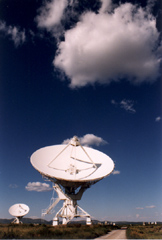
 The VLA is an array of telescopes that can be linked together to
synthesize the resolving power of a telescope upto 36 km (22 miles)
across, or grouped together to synthesize one only a km (0.6 mile)
across: the varying resolutions are the equivalent of an astronomical
zoom lens.
The VLA is an array of telescopes that can be linked together to
synthesize the resolving power of a telescope upto 36 km (22 miles)
across, or grouped together to synthesize one only a km (0.6 mile)
across: the varying resolutions are the equivalent of an astronomical
zoom lens.
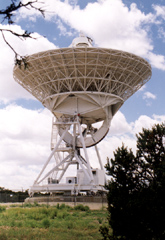
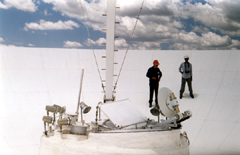
Imagine a telescope sprawling across all of North America: it's possible, using a dedicated supercomputer to link together an array of ten identical radio telescopes, scattered over the U.S. from the Virgin Islands in the Carribean to Mauna Kea in Hawii. And the result is the highest angular resolution telescope ever built.
Here are photos of one of the 10 dishes (the one at Pie Town, New
Mexico), both from the outside and the inside. (Yes, the photo above
is of me and an engineer inside the telescope dish on the right.)
And here is
a link
to some more information about the VLBA.
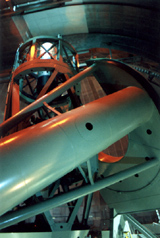
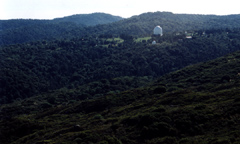 Left: The view from across the valley, with a couple of the domes
just visible through the early evening haze.
Left: The view from across the valley, with a couple of the domes
just visible through the early evening haze.
Right: The Hale Telescope, with surreal lighting inside the dome.
Below: The dome at sunset, with the moon above, and after opening the shutters, while observing at night.
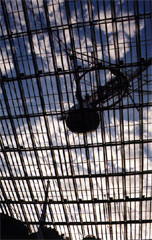
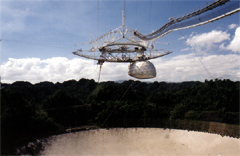 More about the
telescope, and a Tour map.
More about the
telescope, and a Tour map.
Right: A view from under the reflector, which is made of perforated aluminium sheets, shows the platform as well as one of the three support towers.
Left: The platform and the Gregorian dome, with the catwalk leading to it, and the telescope surface far below.
Below: Can radio telescopes be abstract art? Views of the wind spoilers on the anchor cables for the platform, two receivers, and the tertiary reflector inside the Gregorian dome.
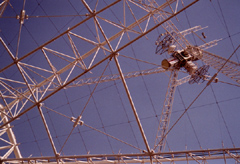
Learn more about the
GMRT here: includes more pretty pictures, too.

|
Shami Chatterjee shami at astro.cornell.edu Last modified: 23 Sep 2003. |